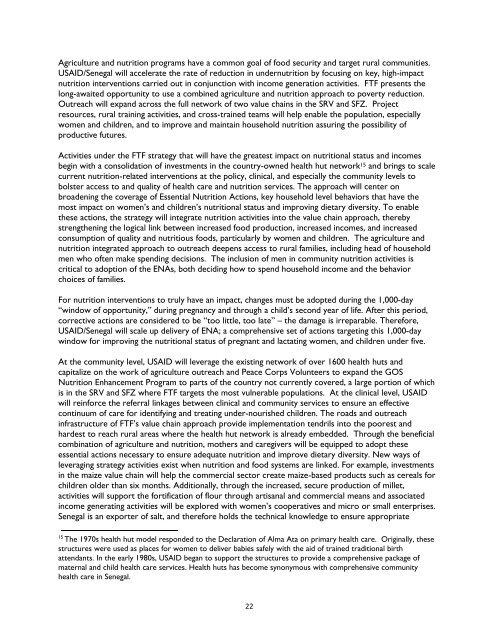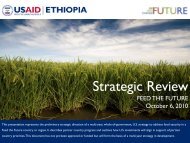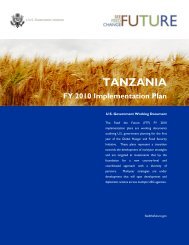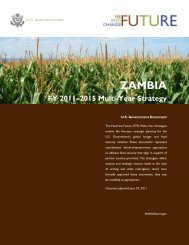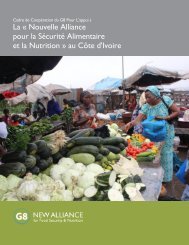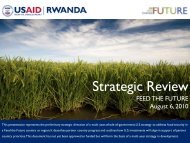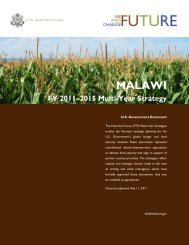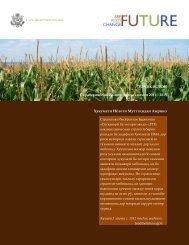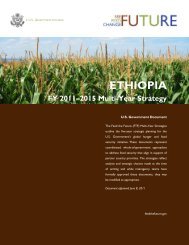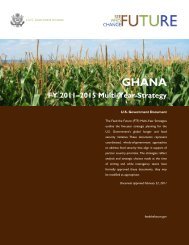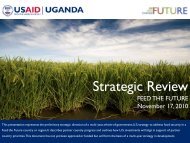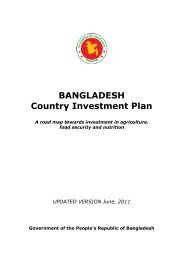Feed the Future Multi-Year Strategy, Senegal, Public
Feed the Future Multi-Year Strategy, Senegal, Public
Feed the Future Multi-Year Strategy, Senegal, Public
Create successful ePaper yourself
Turn your PDF publications into a flip-book with our unique Google optimized e-Paper software.
Agriculture and nutrition programs have a common goal of food security and target rural communities.<br />
USAID/<strong>Senegal</strong> will accelerate <strong>the</strong> rate of reduction in undernutrition by focusing on key, high-impact<br />
nutrition interventions carried out in conjunction with income generation activities. FTF presents <strong>the</strong><br />
long-awaited opportunity to use a combined agriculture and nutrition approach to poverty reduction.<br />
Outreach will expand across <strong>the</strong> full network of two value chains in <strong>the</strong> SRV and SFZ. Project<br />
resources, rural training activities, and cross-trained teams will help enable <strong>the</strong> population, especially<br />
women and children, and to improve and maintain household nutrition assuring <strong>the</strong> possibility of<br />
productive futures.<br />
Activities under <strong>the</strong> FTF strategy that will have <strong>the</strong> greatest impact on nutritional status and incomes<br />
begin with a consolidation of investments in <strong>the</strong> country-owned health hut network 15 and brings to scale<br />
current nutrition-related interventions at <strong>the</strong> policy, clinical, and especially <strong>the</strong> community levels to<br />
bolster access to and quality of health care and nutrition services. The approach will center on<br />
broadening <strong>the</strong> coverage of Essential Nutrition Actions, key household level behaviors that have <strong>the</strong><br />
most impact on women’s and children’s nutritional status and improving dietary diversity. To enable<br />
<strong>the</strong>se actions, <strong>the</strong> strategy will integrate nutrition activities into <strong>the</strong> value chain approach, <strong>the</strong>reby<br />
streng<strong>the</strong>ning <strong>the</strong> logical link between increased food production, increased incomes, and increased<br />
consumption of quality and nutritious foods, particularly by women and children. The agriculture and<br />
nutrition integrated approach to outreach deepens access to rural families, including head of household<br />
men who often make spending decisions. The inclusion of men in community nutrition activities is<br />
critical to adoption of <strong>the</strong> ENAs, both deciding how to spend household income and <strong>the</strong> behavior<br />
choices of families.<br />
For nutrition interventions to truly have an impact, changes must be adopted during <strong>the</strong> 1,000-day<br />
“window of opportunity,” during pregnancy and through a child’s second year of life. After this period,<br />
corrective actions are considered to be “too little, too late” – <strong>the</strong> damage is irreparable. Therefore,<br />
USAID/<strong>Senegal</strong> will scale up delivery of ENA; a comprehensive set of actions targeting this 1,000-day<br />
window for improving <strong>the</strong> nutritional status of pregnant and lactating women, and children under five.<br />
At <strong>the</strong> community level, USAID will leverage <strong>the</strong> existing network of over 1600 health huts and<br />
capitalize on <strong>the</strong> work of agriculture outreach and Peace Corps Volunteers to expand <strong>the</strong> GOS<br />
Nutrition Enhancement Program to parts of <strong>the</strong> country not currently covered, a large portion of which<br />
is in <strong>the</strong> SRV and SFZ where FTF targets <strong>the</strong> most vulnerable populations. At <strong>the</strong> clinical level, USAID<br />
will reinforce <strong>the</strong> referral linkages between clinical and community services to ensure an effective<br />
continuum of care for identifying and treating under-nourished children. The roads and outreach<br />
infrastructure of FTF’s value chain approach provide implementation tendrils into <strong>the</strong> poorest and<br />
hardest to reach rural areas where <strong>the</strong> health hut network is already embedded. Through <strong>the</strong> beneficial<br />
combination of agriculture and nutrition, mo<strong>the</strong>rs and caregivers will be equipped to adopt <strong>the</strong>se<br />
essential actions necessary to ensure adequate nutrition and improve dietary diversity. New ways of<br />
leveraging strategy activities exist when nutrition and food systems are linked. For example, investments<br />
in <strong>the</strong> maize value chain will help <strong>the</strong> commercial sector create maize-based products such as cereals for<br />
children older than six months. Additionally, through <strong>the</strong> increased, secure production of millet,<br />
activities will support <strong>the</strong> fortification of flour through artisanal and commercial means and associated<br />
income generating activities will be explored with women’s cooperatives and micro or small enterprises.<br />
<strong>Senegal</strong> is an exporter of salt, and <strong>the</strong>refore holds <strong>the</strong> technical knowledge to ensure appropriate<br />
15<br />
The 1970s health hut model responded to <strong>the</strong> Declaration of Alma Ata on primary health care. Originally, <strong>the</strong>se<br />
structures were used as places for women to deliver babies safely with <strong>the</strong> aid of trained traditional birth<br />
attendants. In <strong>the</strong> early 1980s, USAID began to support <strong>the</strong> structures to provide a comprehensive package of<br />
maternal and child health care services. Health huts has become synonymous with comprehensive community<br />
health care in <strong>Senegal</strong>.<br />
22


